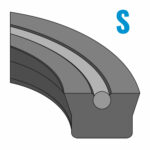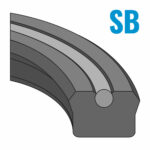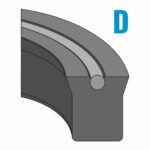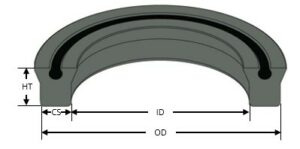U-Cup Seals
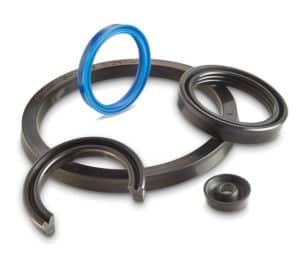 Global O-Ring and Seal’s extensive selection of u-cup seals delivers superior sealing performance across a multitude of applications. With out distinct loaded u-cups designed for high-pressure, dynamic systems, and our standard u-cups offering reliable sealing in both motion and static scenarios, we cater to the full scope of industrial sealing requirements. Each line is tailored to excel in its intended environment, ensuring that you have the precise seal for the task at hand.
Global O-Ring and Seal’s extensive selection of u-cup seals delivers superior sealing performance across a multitude of applications. With out distinct loaded u-cups designed for high-pressure, dynamic systems, and our standard u-cups offering reliable sealing in both motion and static scenarios, we cater to the full scope of industrial sealing requirements. Each line is tailored to excel in its intended environment, ensuring that you have the precise seal for the task at hand.
Loaded U-Cups, also known as “PolyPaks” or “Style 850” seals, are specially designed for hydraulic applications. They are “loaded” with an o-ring within their groove to enhance sealing performance. The o-ring acts as an energizer in low-pressure situations, bolstering the seal’s effectiveness as pressure increases in rod and piston systems. Typically made from polyurethane, alternative materials can be provided upon request to suit your specific needs.
Our standard u-cups are recognized for their unique U-shaped profile that ensures a tight seal across diverse conditions. The edge of the u-cup adapts to the contours of the cylinder or piston, providing a steadfast barrier against leaks, even amidst pressure and temperature fluctuations. The design’s inherent stress distribution prevents uneven wear, thus extending the longevity of both the seal and the machinery it protects.
If you require more information or want to request a quote on u-cups, call us at 832-224-2719 or fill out the Product Inquiry Form.
Technical Specifications
The following table outlines the key operational parameters for our u-cup seals across different seal types. This guide helps you discern the appropriate temperature range, pressure rating, and speed capacity for each type of seal. Utilize this table to accurately determine which seal will meet the specific demands of your system, ensuring efficiency and reliability in your operations.
|
Seal Profile |
Seal Material | Energizer | Temperature Range | Pressure Range |
Speed |
| S | 95 Duro URE | 70 Duro NBR | -31 to +212 °F | 0 – 5,000 PSI |
3 FT/SEC |
| SB | 95 Duro URE | 70 Duro NBR | -31 to +212 °F | 0 – 5,000 PSI |
3 FT/SEC |
| D | 95 Duro URE | 70 Duro NBR | -31 to +212 °F | 0 – 5,000 PSI |
3 FT/SEC |
| DB | 95 Duro URE | 70 Duro NBR | -31 to +212 °F | 0 – 5,000 PSI |
3 FT/SEC |
|
DSU |
90 Duro URE | -40 to +230 °F | 0 – 4,000 PSI |
3 FT/SEC |
Product Inquiry
Part Numbering System
Part numbering follows a specific order: Profile, Cross-Section (in.), Inside Diameter (in.), Height (in.), and optional lip beveling. The left example shows a u-cup that is loaded with an o-ring energizer, has a cross-section of 0.125 inches, an ID of 1.000 inch, a height of 0.250 inches, and is made with a bevel lip. This is a deep style. The right shows a u-cup that is loaded with an o-ring energizer, has a cross-section and height of 0.250 inches, an ID of 1.000 inch, and is made with a bevel lip. This is a Square Style.

U-Cup Profiles
Global O-Ring and Seal offers five tailored u-cup seal profiles to suit a range of industrial applications. Each profile is crafted to meet specific sealing needs, ensuring optimal performance.
S (Square, Straight, Loaded): The ‘S’ profile features a square cross-section with an equal height dimension, providing a balanced seal with a straight lip design that’s loaded to enhance sealing efficiency in dynamic applications.
SB (Square, Bevel, Loaded): Like the ‘S’ profile, the ‘SB’ has a square dimension but with a beveled lip to provide a sharp sealing edge for improved sealing actions under pressure, also loaded for additional energizing in dynamic sealing environments.
D (Deep, Straight, Loaded): The ‘D’ profile has an asymmetrical design where the height exceeds the cross-section. This design, combined with a straight lip and loaded feature, offers enhanced sealing capabilities in applications where height plays a critical role in seal functions.
DB (Deep, Bevel, Loaded): Featuring the same asymmetrical design as the ‘D’ profile and the addition of a beveled lip, the ‘DB’ profile is loaded for applications that demand a strong seal capable of operating under substantial pressure differentials.
DSU (Bevel, Standard): The DSU profile is available with either square or deep dimensions. It’s beveled lip provides an effective sealing edge, and as an unloaded seal, it utilizes system pressure to maintain sealing contact.
Straight vs. Bevel Lip
Global O-Ring and Seal’s u-cups come in straight lip and bevel lip variations, each engineered for specific application needs. When selecting the right seal, it’s vital to understand the difference between the two variations in design to ensure optimal performance and longevity in your application.
Straight lip u-cups are the quintessential choice for high-pressure applications. Their design ensures a uniform seal against the cylinder surface, providing a robust barrier that excels under significant stress. This makes them ideal for heavy-duty machinery where the seal is more static, and the forces it must withstand are substantial. The trade-off for this exceptional pressure resistance is increased friction, which may accelerate wear in applications where the seal is in constant motion.
Bevel lip u-cups are tailored for dynamic environments. The beveled edge of the lip reduces the seal’s surface contact, cutting down friction and facilitating smoother operation. This feature is especially beneficial in high-speed applications such as pneumatic systems, where reducing friction is key to maintaining seal integrity and efficiency. However, it’s important to note that while the bevel lips manage motion, they may not perform as well under low-pressure conditions and can be more prone to displacement if not properly installed.
Size Chart
Looking at the curvature throughout the u-cup, it can be difficult to know where to start and end when measuring the dimensions. To eliminate confusion, cross-section is defined by the width at the bottom of the cup. Inside diameter and outside diameter are also measured from the bottom of the cup. See the diagram below.
The following table describes the most common imperial sizes.
| Size | ID | OD | HT | CS | ID (IN) | OD (IN) | HT (IN) | CS (IN) | ID (MM) | OD (MM) | HT (MM) | CS (MM) |
|---|

 English
English  Español
Español  Français
Français  Português
Português  Deutsch
Deutsch  Italiano
Italiano  Русский
Русский  中文
中文  日本語
日本語  العربية
العربية  हिन्दी
हिन्दी 